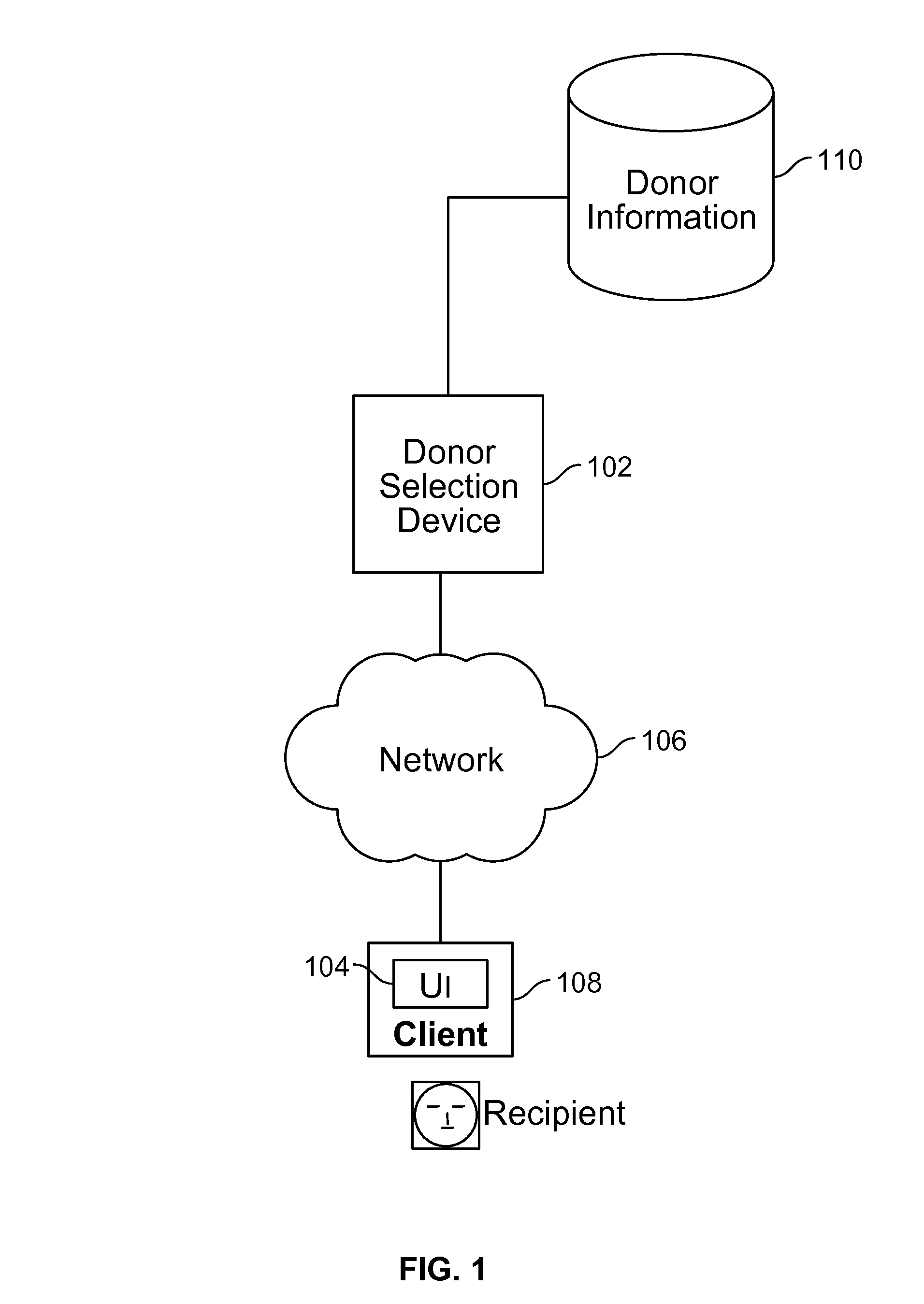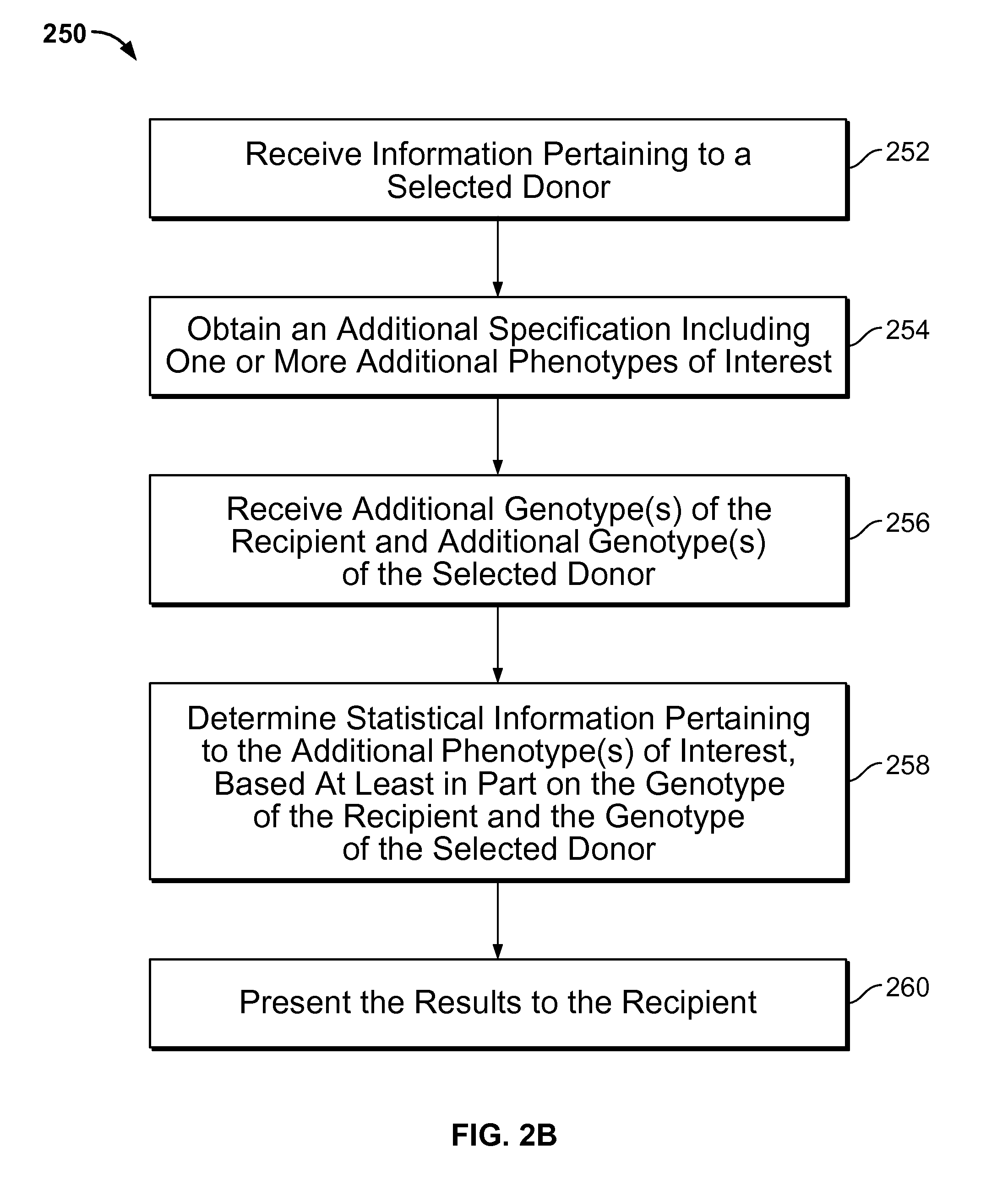Gamete donor selection based on genetic calculations
a genetic calculation and gamete technology, applied in the field of gamete donor selection based on genetic calculations, can solve the problem that the recipient is not able to make an informed choi
- Summary
- Abstract
- Description
- Claims
- Application Information
AI Technical Summary
Problems solved by technology
Method used
Image
Examples
example 1
[0036]In this example, the probability that a hypothetical child will be able to perceive bitter flavors is calculated. About 25% of people are unable to taste a chemical called propylthiouracil (PROP) similar to the bitter components found in cabbage, raw broccoli, coffee, tonic water, and dark beers. These people are considered “taste-blind”—and compared to those who do respond to PROP, taste-blind people find most food and drink to be less bitter, or not bitter at all. Sensitivity to this kind of taste is due almost entirely to a single gene that encodes receptors in taste buds on the tongue. A SNP in this gene, whose identifier is rs713598, is responsible for whether a person is bitter taste-blind.
[0037]rs713598 has two alleles, C and G. In European-descended populations, the C allele has a frequency of about 40%, the G allele about 60%. The possible diploid genotypes for rs713598 are GG, CG, and CC.
[0038]Suppose that a recipient and a potential donor have respective rs713598 ge...
example 2
[0044]In this example, the phenotype of age-related macular degeneration (AMD) is considered. AMD is the most common cause of irreversible vision loss in the Western world among people over 60. Three markers identified as rs1061147, rs547154, and rs3750847 are responsible for this disease. The wild type alleles, the risk alleles, and the occurrence frequency of the risk alleles associated with the SNPs are shown in the table below:
[0045]
TABLE 3WildtypeRiskRisk AlleleSNPAlleleAlleleFrequencyrs1061147CA0.392rs547154TG0.937rs3750847CT0.224
[0046]In this example, the recipient has (rs1061147, rs547154, rs3750847) genotype GR=((A, C), (G, G), (C, C)) and the donor has genotype GD=((A, C), (G, G), (C, T)). Using risk estimation techniques such as the techniques described in U.S. patent application Ser. No. 12 / 151,977 entitled “SUMMARIZING AN AGGREGATE CONTRIBUTION TO A CHARACTERISTIC FOR AN INDIVIDUAL,” filed May 8, 2008, which is incorporated herein by reference for all purposes, it is es...
example 3
[0050]This example illustrates the problem of non-independent phenotypes. For this example, it is assumed that for a certain population group, heart disease occurs in 20% of those with an AA genotype at a given marker, and type 2 diabetes occurs in 30% of those with the AA genotype. Were the phenotypes independent, one would expect heart disease and diabetes to covary multiplicatively as follows:
[0051]
TABLE 5No Heart DiseaseHeart DiseaseNo Diabetes56%14%Diabetes24% 6%
[0052]As used herein, “covary multiplicatively” means that the expected frequency of a combination of phenotypes is the product of the individual probabilities. For example, if the phenotypes are truly independent, one would expect people to simultaneously suffer from both heart disease and diabetes at a frequency of 20% *30%=6%, as in the lower right cell. Suppose, however, that it is empirically observed that the joint phenotype frequencies within those who have the AA genotype are as follows:
[0053]
TABLE 7No Heart Dis...
PUM
 Login to View More
Login to View More Abstract
Description
Claims
Application Information
 Login to View More
Login to View More - R&D
- Intellectual Property
- Life Sciences
- Materials
- Tech Scout
- Unparalleled Data Quality
- Higher Quality Content
- 60% Fewer Hallucinations
Browse by: Latest US Patents, China's latest patents, Technical Efficacy Thesaurus, Application Domain, Technology Topic, Popular Technical Reports.
© 2025 PatSnap. All rights reserved.Legal|Privacy policy|Modern Slavery Act Transparency Statement|Sitemap|About US| Contact US: help@patsnap.com



